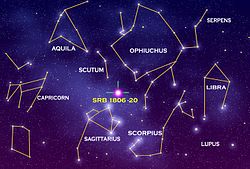SGR 1806-20
| Observation data Epoch J2000 Equinox J2000 |
|
|---|---|
| Constellation | Sagittarius |
| Right ascension | 18h 08m 39.32s |
| Declination | −20° 24' 39.5"' |
| Apparent magnitude (V) | totally obscured |
| Astrometry | |
| Distance | 50,000 ly (14,500pc) |
| Other designations | |
|
GRB 790107, INTEGRAL1 84, AX 1805.7-2025 GRB 970912, INTREF 882, CXOU J180839.3-202439, HETE Trigger 1566, KONUS 07.01.79, EQ 1805.7-2025, HETE Trigger 3801, PSR J1808-2024, GBS 1806-20, HETE Trigger 3800, RX J1808.6-2024
|
|
| Database references | |
| SIMBAD | data |
SGR 1806-20 is a magnetar, a particular type of neutron star. It was discovered in 1979 and has been identified as a soft gamma repeater. SGR 1806-20 is located about 14.5 kiloparsecs (50,000 light-years) from Earth on the far side of the Milky Way galaxy in the constellation of Sagittarius. It has a diameter of no more than 20 kilometres (12 mi) and rotates on its axis every 7.5 seconds (30,000 km/h rotation speed at the surface). As of 2016[update], SGR 1806-20 is the most highly magnetized object ever observed, with a magnetic field over 1015gauss (1011tesla) in intensity (compared to the Sun's 1–5 gauss). SGR 1806-20 has a magnetic field that is 1-2 times stronger than that of the Earth.
A starquake occurred and the radiation from an explosion on the surface of SGR 1806-20 reached Earth on December 27, 2004 (GRB 041227). In terms of gamma rays, the burst had an absolute magnitude around −29. It was the brightest event known to have been sighted on this planet from an origin outside the Solar System. The magnetar released more energy in one-tenth of a second (1.3×1039J) than the Sun has released in 100,000 years (4×1026W × 3.2×1012 s = 1.3×1039 J). Such a burst is thought to be the largest explosion observed in the galaxy by humans since the SN 1604 supernova observed by Johannes Kepler in 1604. The gamma rays struck the Earth ionosphere and created more ionization, which briefly expanded the ionosphere.
...
Wikipedia

